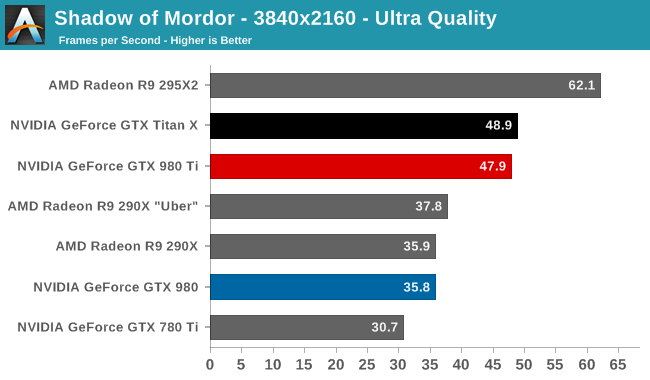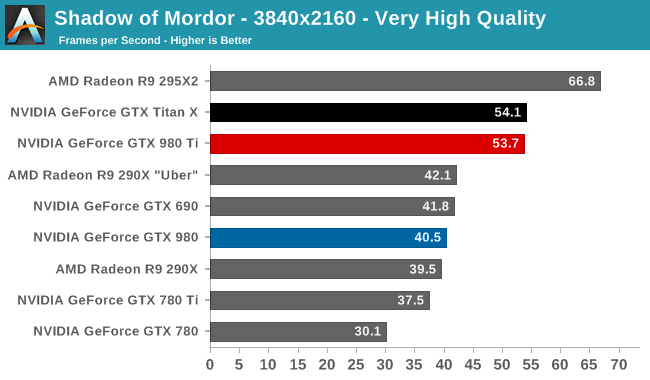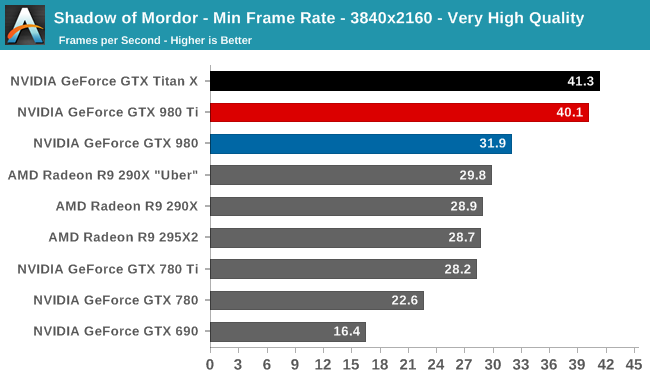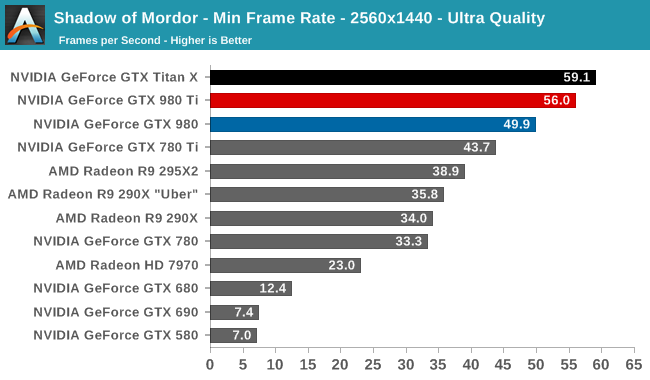The NVIDIA GeForce GTX 980 Ti Review
by Ryan Smith on May 31, 2015 6:00 PM ESTMiddle Earth: Shadow of Mordor
Our next benchmark is Monolith’s popular open-world action game, Middle Earth: Shadow of Mordor. One of our current-gen console multiplatform titles, Shadow of Mordor is plenty punishing on its own, and at Ultra settings it absolutely devours VRAM, showcasing the knock-on effect of current-gen consoles have on VRAM requirements.



Another game, another set of benchmarks where the GTX 980 Ti and GTX Titan X are more or less tied. In this case the latest GM200 card closes the tiny gap even more, bringing the difference between the two down to 1-2% in favor of the GTX Titan X. Meanwhile the GTX 980 Ti’s advantage over the GTX 980 is as strong as ever, beating the most powerful of the GM204 cards by 30% or more.
On an absolute basis, as with Crysis 3 GTX 980 Ti won’t be enough for 60fps at 4K, but at 47.9fps it’s closer to 60fps than 30fps, representing a significant improvement in 4K performance in only a generation. Turning down the game’s quality settings to Very High does improve performance a bit, but at 53.7fps it’s still not quite enough for 60fps. The biggest advantage of Very High quality is alleviating some of the high VRAM requirements, not that the GTX 980 Ti seems to mind even at 6GB. Otherwise dropping to 1440p will give us a significant bump in performance, pushing framerates over 80fps once again.



Looking at minimum framerates, we find the one and only place under which the GTX 980 Ti may be struggling to keep up with its Titan sibling. While it held very close to the GTX Titan X in average framerates, the minimum framerate finds a larger, distinct gap between the two, with the GTX 980 Ti trailing by 8%. That said, minimum framerates are inherently more unreliable than averages, and other than a momentary dip the GTX 980 Ti is doing quite well here, so while it’s a less-than-perfect showing, I don’t believe we’re seeing any kind of real impact from VRAM differences. Note that the 4GB cards don’t seem to be worse off despite being short a further 2GB of VRAM.










290 Comments
View All Comments
przemo_li - Monday, June 1, 2015 - link
Fiji is NOT gpu name.Its gpu segment name.
Just like VI, SI, and some more.
Its chip name if anything.
If we for a moment switched to CPU-speak, You just claimed that Puma is single CPU from AMD ;)
Refuge - Monday, June 1, 2015 - link
It is the name of a GPU Architecture. Which could be a one run chip, or it could have multiple versions based on binning.dragonsqrrl - Monday, June 1, 2015 - link
It's not a GPU architecture. GCN is a GPU architecture, Maxwell is a GPU architecture. Fiji is a GPU, GM204 is a GPU. This isn't exactly a new paradigm we're dealing with here. Oh dear, I think I might be telling someone something (aka trolling***). I've done it again.dragonsqrrl - Wednesday, June 3, 2015 - link
First, that's a terrible analogy. Puma is not a CPU, it's a CPU architecture, successor to Jaguar. Fiji is a GPU, I never once assumed or suggested that there will be a single Fiji SKU (that was all you), right now it's likely there will be 2 for the consumer market.I'm honestly not sure what you meant by "segment", perhaps you could clarify? Are you talking about AMD's XT/PRO convention? They're still the same GPU, pro is typically just a harvested XT.
Refuge - Monday, June 1, 2015 - link
They released more than four if you include mobile GPU's I believe it goes up 2 more to 6.dragonsqrrl - Monday, June 1, 2015 - link
What do you mean mobile GPU's? Are you talking about the 900m series? There are no mobile specific GPU's in that lineup. It's all binned GM204 and GM107 SKU's.eanazag - Sunday, May 31, 2015 - link
Interesting observation. I see the same behavior, but the situations are different. Both major graphics vendors are stuck on 28 nm. The 285 is a new product. AMD's graphic situation is not even close to the same as CPU. They are not even competitive in most of the markets for CPU. AMD will likely release a very competitive GPU, which is why NV is releasing the Ti now.dragonsqrrl - Sunday, May 31, 2015 - link
Yes, the 285 is a new product, and while it is an improvement and a step in the right direction, Tonga just isn't enough to address the issue of AMD's profit margins this coming generation, or make them anymore competitive in mobile (M295X). It would be as though Nvidia were selling the 980 at the $200 price point. Not exactly, but from a memory interface, die size, PCB complexity, power consumption perspective, that's basically what AMD is doing right now, with no solution forthcoming. But I guess it's better than selling Tahiti for $200."AMD's graphic situation is not even close to the same as CPU. They are not even competitive in most of the markets for CPU. AMD will likely release a very competitive GPU, which is why NV is releasing the Ti now."
Some might argue they aren't competitive in the dGPU market with Nvidia market share approaching 80%... some might say that's like Intel levels of dominance...
And I didn't say it's the same as their CPU situation, I said it's becoming more similar. While AMD will likely be competitive in raw performance, as I've tried to explain in my past 2 comments, that's kind of besides the point.
chizow - Sunday, May 31, 2015 - link
Yes, both are stuck on 28nm, but only Nvidia came out with a comprehensive ASIC line-up knowing we'd be stuck here for another 2 years (going back to 2H 2014). It is obvious now that AMD's cost-cutting in staff and R&D is starting to manifest itself as they simply can't keep up while losing ground on 2 fronts (CPU and GPU).The culmination of this will be AMD going to market with a full series of rebrands of mostly old parts going back to 2011 with a single new ASIC at the top of their stack, while Nvidia has fully laid out its arsenal with GM107 (1 SKU), GM206 (1 SKU), GM204 (2 SKU), and now GM200 (2 SKU).
Kevin G - Monday, June 1, 2015 - link
Is it unprecedented? I recall the Geforce 9000, GTS 100 and most of the GTX 200 series being various rebrands from 'generation' to 'generation'. In fact, the 8800GTS 512 MB, 9800GTX, GTS 150 and GTS 250 were all the same chip design (the GTS 250 had a die shrink but was functionally unchanged).nVidia has gotten better since then, well with the exception of the GF108 that plagued the low end for far too long.